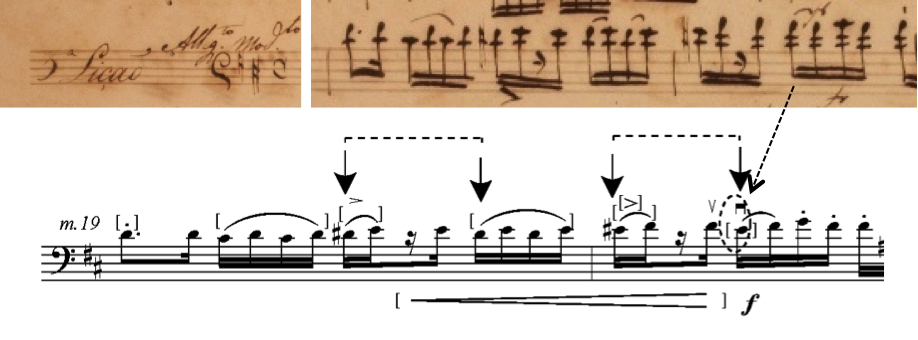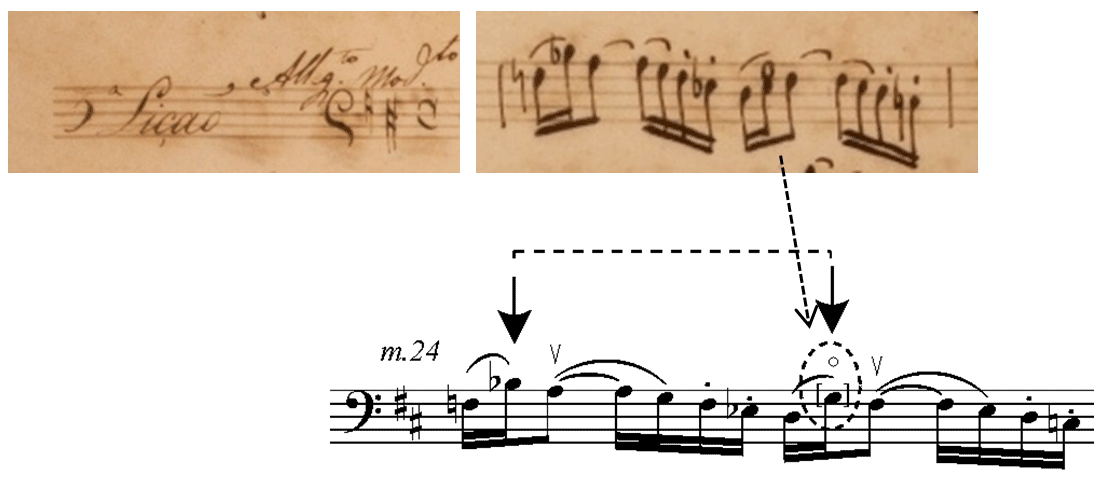| |
Volume 5, April 2015
Lino José Nunes's 1838 Methodo : Historical, Analytical and Editorial aspects of an Afro-Brazilian Double Bass Jewel
by Fausto Borém, Alfredo Ribeiro, Gustavo Neves, João Paulo Campos, and Rodrigo Olivarez
4. Bringing Lino José Nunes's Lessons back to life: decisions in the performance editions
Reviewing consolidated philological references in music, Figueiredo (2012; 2004, p.40) presents the typologies by Georg Feder (eight categories), James Grier (four categories) and Maria Caraci Vela (five categories) to finally propose a taxonomy with seven categories for score editions. Although these authors present common features as far as the edition of scores aiming at performances20 are concerned, a hybrid type of performance edition and musicological edition is proposed in this paper. Here, the option for performance editions was made having in mind that most double bassists still are not familiar with the realization of HIP performance practices in urtext scores. However, all changes in the originals were placed between brackets in the performance editions so the reader can easily identify the editor's interferences. Bowings and indication of strings, absent in the originals, were added at the editor's discretion. Nunes's manuscript is well preserved and reflects a very careful calligraphy. However, formal and harmonic analysis, melodic contour, symmetry, recurrence, and development of thematic materials were used to identify and correct/regularize wrong notes and inconsistences of rhythms, and placement of articulations and dynamics. Next, the main editorial decisions are explained in each lesson.
There are three wrong notes in the manuscript of Lesson 1. At the beginnings of m.11 and m.19, Nunes placed a sharp in the F3 notes to make them lower neighboring tones to G. However, these sharps should not be carried over to the next F3 in the same measures. Thus, they received naturals in the performing edition (Ex.18). Finally, the last note of m.14 should be a B3 and not an A3, since it is part of a descending scale (see Ex.8 above).
Ex.18 - Correction of a wrong note (an F natural instead of an F sharp in m.11) in the performance edition of Nunes's Lesson 1, and suggestions of string, open string signs, dynamics, and alternate bowing and slur.
Only one indication of dynamics appears during the whole Lesson 1: a forte in the last measure, which can be understood as a sign of possible previous dynamics changes. As Nunes focused on few elements in this introductory lesson, terraced forte-piano dynamics pairs, based on the explicit double period pattern, were added to the score. Obvious missing ties and staccato signs were corrected (mm.2, 6 and 28). A ritardando-crescendo pair was added to m.15, allowing the bassist to not reach the opera fermata abruptly (see Ex.8 above). This also serves the purpose of bringing the bow closer to the tip in order to allow for more time to hold that suspension during the up bow. Still in m.15, an open string symbol ("o") was added to the D3 under the fermata as it would be a natural performance practice of the time. Two consecutive up bows were suggested on the second beat of m.22-25, 28, 30, and 32-33 in order to keep the bow closer to the frog and facilitate the staccati in the descending scales.
There was only one wrong note in Lesson 2. The D3 at the beginning of m.16 should be a C3 as it is the turning point of the melodic contour and outlines the F major chord in the second inversion. Symmetry was central for editing this lesson. For example, by crossed comparison (Ex.19), similar decisions were made for the marcati in mm.23-25 (applied to m.19-21) and hairpin pairs (crescendo-decrescendo) signs in mm.19-21 (applied to m.23-25). At a higher level, the staccati in the thematic 8th notes preceding the syncopation in m.13 and the martial pick up in m.29 were applied to the many corresponding inconsistent spots. The emphasis on the second beats of the martial syncopations occupying a whole measure (quarter note - half note - quarter note) were secured with the notation of a down bow on the second beat, which sometimes resulted in two consecutive down bows or two consecutive up bows (mm.2-3). The very inconsistent dynamics notation was mitigated by parallel reasoning. For example, there is no dynamic indication between the piano in the pick up to m.1 and the piano in m.8. Thus, a forte was added to the pick up to m.5 as it marks the second half of the parallel period. Other types of echo structures also received forte and piano indications (m.12 and m.15, m.19 and m.23, m.32 and m.34, m.43 and m.44, m.45 and m.46). Still in relation to bowings, reversed bows (up and down bows on strong and weak beats, respectively) were suggested to make clearer the staccato and slurred notes in m.48.
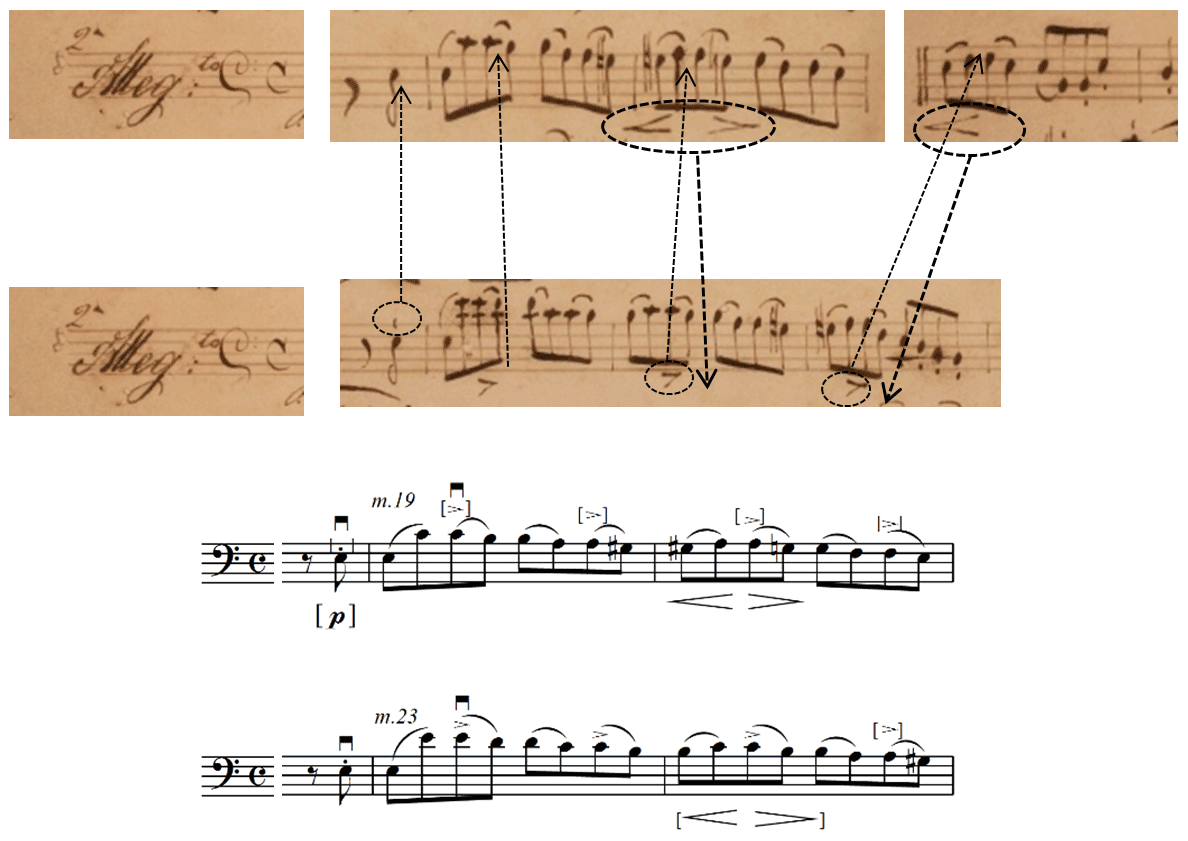 Ex.19 — Crossed comparison in parallel passages allowed the inclusion of articulation signs (staccato and marcato) and dynamic signs (hairpins) in the performance edition of Nunes's Lesson 2.
There are two wrong notes in the manuscript of Lesson 3. First, the E3 in m.20 should be a G3 (Ex.20), which can be inferred by the other six recurrences of the same note in m.18-20 and the fact that all melodic contours around it converge to this open string, a resource idiomatically used by Nunes. The second wrong note is due to a wrong octave designation: the G4 in m.26 (written in tenor clef) should be a G3 (Ex.21) to not break the descending G major triad after the 16th-note scales (m.24-25) reach their climax. Nunes's use of the open G string motivated the inclusion of the open string and natural harmonics signs in several G and D notes throughout the lesson to emphasize the intended reverberation. Slurs were added to the notes in the feminine cadence in m.4 (G#3-A3) and the appoggiatura in m.28 (E4-D4). Slurs and marcato signs were added to the sequence of syncopations in the last measure (C#4-D4 and A3#-B3) in order to characterize the performance practice of emphasizing the so-called Brazilian syncopation, reflecting the emerging African influence in the popular genres of modinha and lundu (Lima, 2005, p.49). As it happened in Lesson 2, consecutive down bows were added to the martial syncopation of m.2 and m.6. In order to make the realization of the double appoggiatura in m.3 easier, a slur connecting it to the next note (an A3) was added. The echoes of mm.12-14 in mm.15-17 and of mm.18-19 in mm.20-21 led to the inclusion of forte-piano pairs. A forte was also added to m.22 due to the typical symphonic tutti nature of the arpeggio and scales that almost covers the double bass tessitura (B flat2 to G4) used by Nunes on this passage.
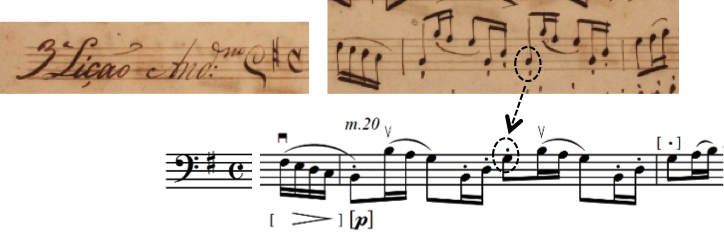 Ex.20 — Note correction in in the performance edition of Nunes's Lesson 3: G3 (and not E3) in m.20, based in other recurrences in the passage.
Ex.21 — Another note correction in the performance edition of Nunes's Lesson 3: G3 (and not G4) in m.26, based on the descending arpeggio line contour.
As far as wrong notes are concerned, only one was detected in Lesson 4: the D3 at the end of m.15 should be a D3 sharp in order to work as the leading tone of E minor. To keep the same string timbre, the use of the D string was suggested for the whole chromatic passage in mm.10-13. As it happened in Lessons 1 and 2, martial syncopations were emphasized with down bows on the second beat of mm.1, 2, 5, 6, 18 and 21. Retaking the bow was also suggested in mm.30-31 to keep the bow at the frog and its clear articulation. A crossed comparison of the parallel periods in mm.1-4 and mm.5-8 (Ex.22) made clear the inconsistent notation of their paired dynamics. While the piano and forte in m.1 were added to m.5, the marcato in the syncopation of m.5 was added do m.1. The piano in m.3 was anticipated to the end of m.2 because of its position in m.6, which makes more sense regarding the phrasing.
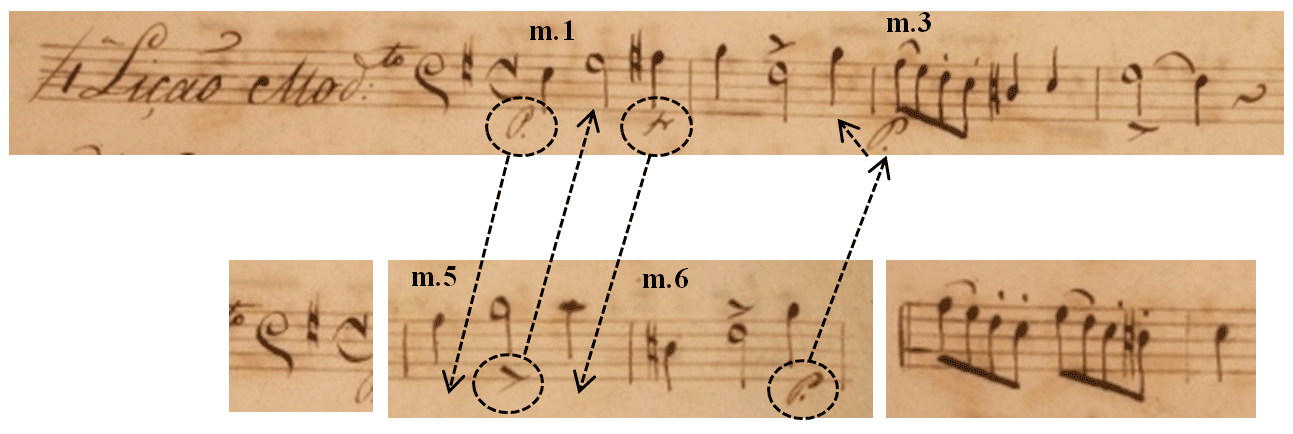 Ex.22 — Crossed comparison of parallel periods (mm.1-4 and mm.5-8) allowed the inclusion /correction of missing dynamics and articulations in the performance edition of Nunes's Lesson 4.
Although no hairpins were found in Lesson 4, expressive chromatic passages and typical climaxes typically constructed with ascending scales and descending arpeggios motivated the notation of operatic crescendi and decrescendi. The sudden tempo changes, reflecting the aria-caballeta pair, were prepared with suggested ritardandi (m.16 and m.23) and a fermata in the dominant (m.29)before the resolution in the tonic (m.30). In the same passage, in order to connect the trill to the fermata in m.29, the ornament of a turn (typical for the solo string repertory) was suggested. The original staccati in the 16th notes of m.14 were applied to similar passages in mm.16-17. The two layers of the polyphonic melody in m.24-28 were emphasized with the regularization of the contrasting articulations found in the manuscript: staccato for the 8th notes and marcato for the quarter notes.
There are two wrong notes in the manuscript of Lesson 5 (Ex.23). The first note on the second beat of m.19 should be an E#4 sharp instead of an F#4, due to the recurrent pattern of a semitone lower appoggiatura in the same measure and in the previous measure. On the third beat of m.24, the E3 should be a G3 not only because it happens in a melodic sequence of the first beat (an ascending 4th followed by a descending minor 2nd), but also because the little circle on top of it is the symbol of an open string.
Ex.23 — Correction of two wrong notes in the performance edition of Lesson 5: the E#4 (m.19), based on its appoggiatura role; and the G3 (m.24), based on the recurrent melodic pattern and the open string symbol notated in the manuscript.
Patterns in parallel phrasing guided the correction of inconsistent articulation and dynamics in Lesson 5. For example, the marcato accents in m.1 were copied to m.5. Both slurs over the two 16th-note groups in m.17 were copied onto the same patterns in m.18. The slur in the last two notes of m.25 was applied to the correspondent notes in both m.22 and m.28. Likewise, the articulations in the 16th notes of the third and fourth beats of m.30 were copied to the notes on the first and second beats of the same measure. Chromatic stepwise appoggiaturas are a very recurrent trait in Lesson 5 (m.2, 4, 6, 8, 13, 18 and 19), to which slurs were added in order to highlight the typical performance practice of a diminuendo in such cases. As it happened in Lesson 3, Nunes explores the reverberation of open strings in Lesson 5, especially in long notes. Thus, the small circle sign was placed on top of several A2, D3 and G3 notes. To facilitate the reading of the score, the ornament symbol for the turn in m.23 was substituted by its realized form. Although the notation of dynamics is very inconsistent (the first sign appears only in m.6), the symmetry of phrasing and harmonic progressions allowed several suggestions. The emphases caused by large leaps (B2–G4 in m.15 and D3-G4 in m.32) and syncopations (mm.22, 25 and 28) were stressed by retaking down bows. Alternative two-note slurs were given to facilitate the articulation of a G flat major passage on the D string.
There are no wrong notes in Lesson 6. However, two grace notes missing right before the fourth beats of m.7 and m.8 (Ex.24) were added. Alternative slurs and bowings were suggested in the performance edition with the aim of keeping the beginning of all 16th-note groups starting with a down bow and staying near the frog for the purpose of an easier and clearer articulation.
Ex.24 — Correction of two missing grace notes (m.7 and m.8) in the performance edition of Lesson 6, and an added ossia for alternate bowings to help a clearer realization of this virtuosic passage.
To mirror mm.15-16, the notation of the turn in m.6 was changed to its realized form. As it happened in Lesson 4, the suggestion of the operatic aria-cabaletta pair was prepared with a ritardando before the 1° Tempo (i.e., Tempo primo) in m.19. At the same time, a forte was added at this tempo change because it reflects a bravura section with typical 16th note runs with an "apertando" (i.e., an accelerando). Also, there is no other dynamic marking between the forte piano subito in m.18 and the diminuendo at the end of the lesson, in m.24. Two consecutive up bows were suggested at the 16th-note groups in mm.8-9 to keep the bow closer to the frog and help the articulation of this very ornamented passage. Similarities of character and melodic structure guided the inclusion of accents in several passages, such as in mm.1-2, mm.11-12 and mm.15-18.
|
|






